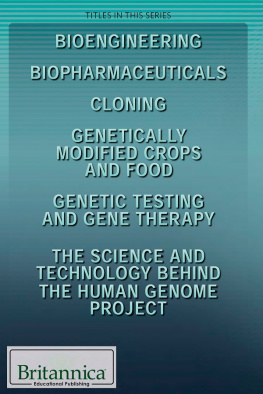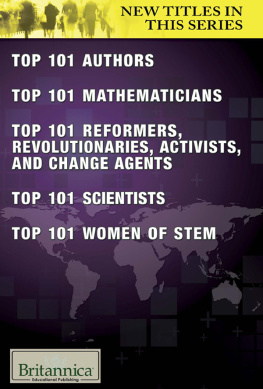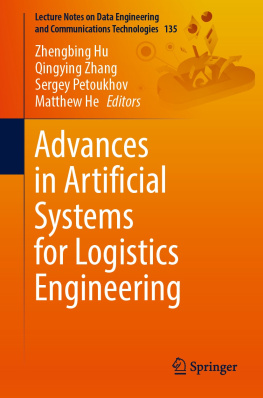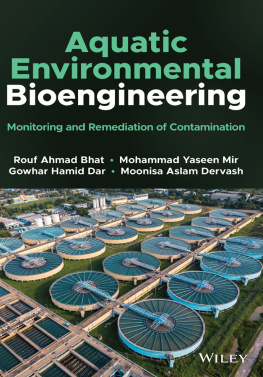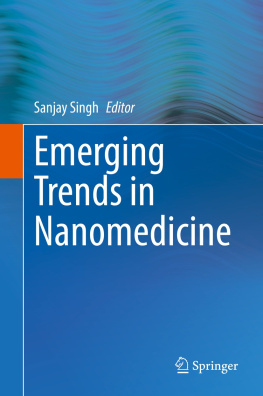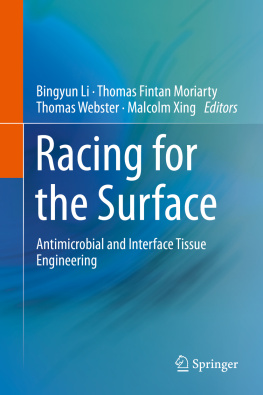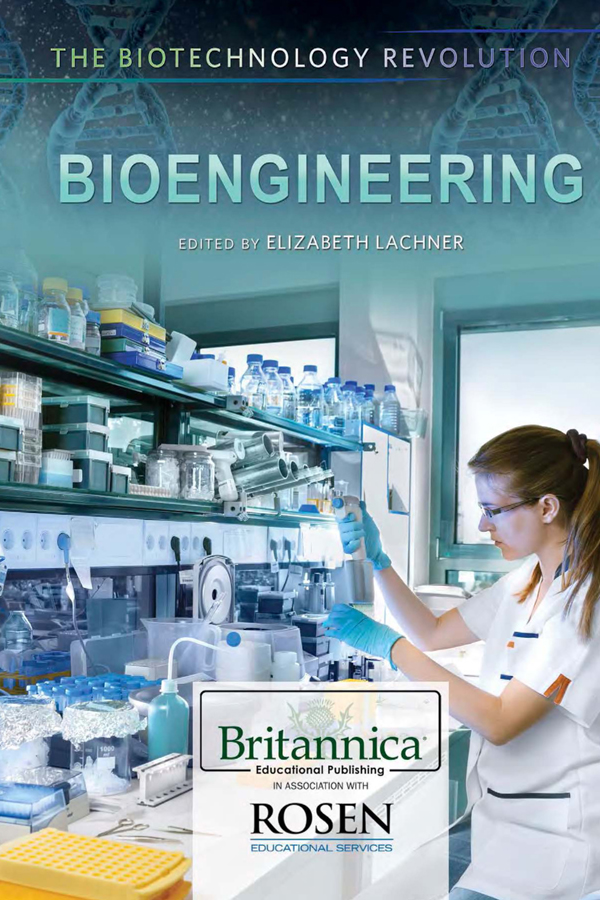
Published in 2016 by Britannica Educational Publishing (a trademark of Encyclopdia Britannica, Inc.) in association with The Rosen Publishing Group, Inc.
29 East 21st Street, New York, NY 10010
Copyright 2016 by Encyclopdia Britannica, Inc. Britannica, Encyclopdia Britannica, and the Thistle logo are registered trademarks of Encyclopdia Britannica, Inc. All rights reserved.
Rosen Publishing materials copyright 2016 The Rosen Publishing Group, Inc. All rights reserved.
Distributed exclusively by Rosen Publishing.
To see additional Britannica Educational Publishing titles, go to rosenpublishing.com.
First Edition
Britannica Educational Publishing
J.E. Luebering: Director, Core Reference Group
Rosen Publishing
Hope Lourie Killcoyne: Executive Editor
Amelie von Zumbusch: Editor
Nelson S: Art Director
Brian Garvey: Designer
Cindy Reiman: Photography Manager
Library of Congress Cataloging-in-Publication Data
Bioengineering/edited by Elizabeth Lachner.First edition.
pages cm.(The biotechnology revolution)
Includes bibliographical references and index.
ISBN 978-1-6227-5581-3 (eBook)
1. BioengineeringJuvenile literature. 2. BiotechnologyJuvenile literature. I. Lachner, Elizabeth, editor.
TA164.B45 2015
660.6dc23
2014047675
Photo credits: Cover, p. 1 anyaivanova/Shutterstock.com; pp. viiiix Bloomberg/Getty Images; p. 5 JPC-PROD/Fotolia; p. 11 Leonard Lee Rue lll/Science Source/Getty Images; pp. 14, 42, 68, 79, 84, 107, 146, 150, 161 Encyclopdia Britannica, Inc.; p. 18 Keith Brofsky/Photodisc/Thinkstock; p. 25 serts/E+/Getty Images; pp. 3233 kristian sekulic/E+/Getty Images; pp. 3839 monkeybusinessimages/iStock/Thinkstock; pp. 4445, 112 BSIP/UIG/Getty Images; p. 49 Walter Reed/U.S. Army; p. 58 Hank Morgan/Science Source/Getty Images; p. 60 Apogee/Science Source; pp. 6465 Burger/Phanie/Science Source; p. 72 Scott Camazine/Science Source/Getty Images; p. 89 Magan-Domingo/age fotostock/Getty Images; pp. 9495, 114115, 134 Science Source; p. 99 James King-Holmes/Science Source; p. 124 Tom Deerinck and Mark Ellisman of the National Center for Microscopy and Imaging Research at the University of California at San Diego; p. 140 huimin/Fotolia; p. 154 Aerial Achives/Alamy; cover and interior design elements vitstudio/Shutterstock.com (DNA), everythingpossible/iStock/Thinkstock (honeycomb), style_TTT/Shutterstock.com (linear patterns).
CONTENTS
I n 2013, bioengineers from Cornell University and physicians from Weill Cornell Medical College published a study describing how they were able to use a 3-D printer to produce artificial ears that look and act like real ears. The team, lead by Lawrence Bonassar and Dr. Jason Spector, fed a 3-D image of a human ear to a 3-D printer, which was able to use the image to create a mold of a human external ear. They filled the mold with collagen that came from rat tails, which provided a framework on which cartilage cellsfrom cow earsthat were then added could grow. In the future, the team hopes to be able to use human cartilage cells grown in a lab in the place of ones from cows. The plan is that these artificial ears could be used on children who are born with microtia, a congenital deformity in which the external ear does not fully develop. The artificial ears could also potentially be used to replace external ears that were lost to cancer or in accidents.
Scientists are also experimenting with various techniques to grow artificial human skin. An international team headed by Dr. Theodora Mauro, from San Francisco Veteran Affairs Medical Center, and Dr. Dusko Ilic, from Kings College London, announced in 2014 that it had used stem cells to grow 1-centimetre (.39-inch) wide patches of epidermis, as the outer layer of human skin is known. The samples had the same properties as normal human skin. The scientists hope that the epidermis fragments could be used to test medicines and cosmetics. This would avoid the need for testing on animals, which can be less accurate than testing on humans and is a controversial procedure, banned in some areas.
While these accomplishments are impressive, theyre just the latest in a long line of incredible advances that have been made over the last century. Take, for example, the first implant of an artificial lens in a human eye, which was made by Dr. Harold Ridley on Nov. 27, 1947, at Londons Saint Thomas Hospital. While treating Royal Air Force (RAF) pilots during World War II, Ridley had noticed that when small pieces of PPMA (a certain kind of plastic that was used for the windshields and cupolas of RAF planes) got into the pilots eyes after plane crashes, the pilots eyes did not reject them. This got him thinking about how the same material could be used to make artificial lenses to replace damaged ones.
All of these impressive efforts are examples of bioengineering at work. Bioengineering is the application of engineering knowledge to the fields of medicine and biology. The bioengineer must be well grounded in biology and have engineering knowledge that is broad, drawing upon electrical, chemical, mechanical, and other engineering disciplines. The bioengineer may work in any of a large range of areas. One of these is the provision of artificial means to assist defective body functionssuch as hearing aids, artificial limbs, and supportive or substitute organs. In another direction, the bioengineer may use engineering methods to achieve biosynthesis of animal or plant productssuch as for fermentation processes.
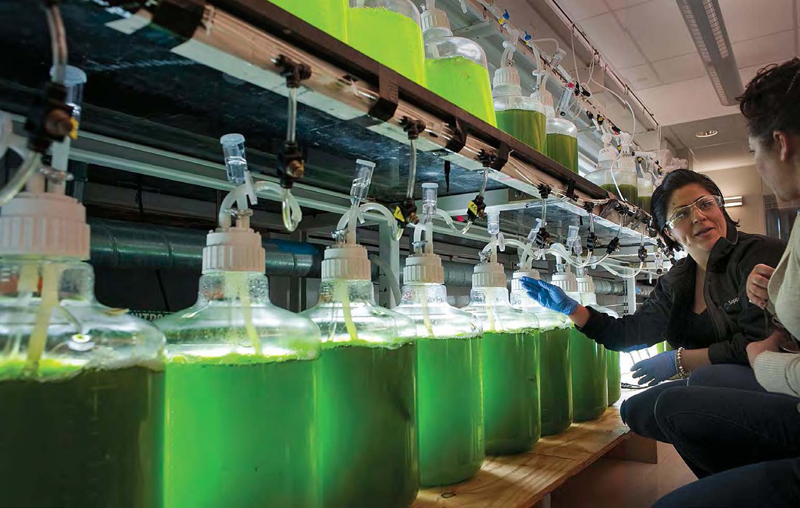
Bioengineers at Sapphire Energy, Inc., in San Diego, Calif., use cultivated algae to produce crude oil, lessening the need for oil drilling.
Lets take a closer look at the two elements of the word bioengineering. The prefix bio indicates something having to do with life or living organisms, as is evident in the word biology, meaning the study of living things and their vital processes. Biology deals with all the physicochemical aspects of life. The basic principles of biology include homeostasis (that all living things maintain a constant internal environment), unity (that all living organisms, regardless of their uniqueness, have certain biological, chemical, and physical characteristics in common), evolution (that the various types of plants, animals, and other living things on Earth have their origin in other preexisting types and that the distinguishable differences are due to modifications in successive generations), diversity (that, despite the basic biological, chemical, and physical similarities found in all living things, a diversity of life exists not only among and between species but also within every natural population), interrelationship (that living things have an impact on each other and on their environment), and continuity (that the ability to reproduce is one of the most important characteristics of life).
Engineering is the application of science to the optimum conversion of the resources of nature to the uses of humankind. The field has been defined by the Engineers Council for Professional Development as the creative application of scientific principles to design or develop structures, machines, apparatus, or manufacturing processes, or works utilizing them singly or in combination; or to construct or operate the same with full cognizance of their design; or to forecast their behaviour under specific operating conditions; all as respects an intended function, economics of operation and safety to life and property. Associated with engineering is a great body of special knowledge; preparation for professional practice involves extensive training in the application of that knowledge. Standards of engineering practice are maintained through the efforts of professional societies, usually organized on a national or regional basis, with each member acknowledging a responsibility to the public over and above responsibilities to his employer or to other members of his society.

